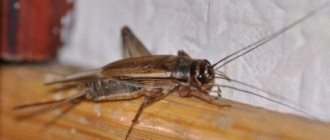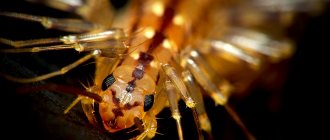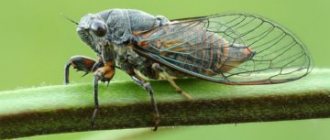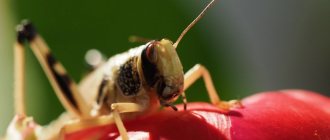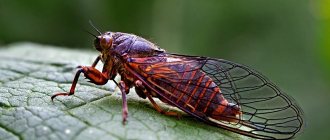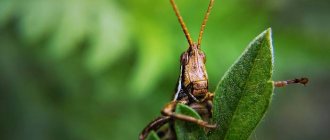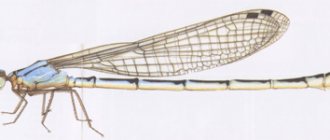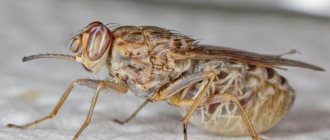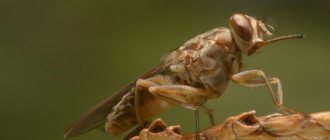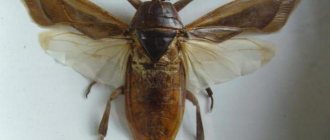The word “cicada” is, of course, familiar to everyone. It is this that comes to mind of most people when hearing the sounds produced by any chirping insects, and the cicada itself is considered to be some kind of close relative of grasshoppers or crickets. At least, this is how things are here in the middle zone. In fact...
In fact, if the cicada and the grasshopper can be considered relatives, then they are very, very distant.
I first became acquainted with cicadas in my distant childhood, leafing through the book “Identifier of Insects of the European Part of the USSR”, then I saw them a couple of times in Crimea in the 90s, but I only came across them closely in the summer of 2014.
Cicada on a branch
I had to walk a lot along the shores of the Black Sea, where in mid-July the air is filled with the endless chirping of thousands of cicadas coming from all sides. But these insects like to sit on tree branches at a height higher than human height, and their protective coloration often allows them to remain unnoticed, even being in the center of the observer’s field of vision.
Common cicada
Complete with protective coloring, cicadas are extremely cautious and agile, rarely allowing themselves to be approached closer than a meter. But when all the trees in a low-growing coastal forest are literally teeming with these insects, the task of finding and catching them becomes a simple matter. And then, finally, having examined the cicadas up close and held them in my hands, I was impressed, which is what I’m sharing.
Common cicada (Lyristes plebejus)
The common cicada belongs to the song cicada family, which includes about 2,500 species.
- Type: Arthropods
- Class: Insects
- Order: Hemiptera
- Suborder: Cycads
- Infraorder: Cicadomorpha
- Superfamily: Cicadoidea
- Family: Song cicadas
- Genus: Lyristes
- Species: Common cicada ( Lyristes plebejus)
Locust
It is possible that a locust or grasshopper is giving a concert in your garden. This is the closest relative of grasshoppers, found almost everywhere except in the coldest areas. They feed only on plants.
Locusts have become notorious for their monstrous appetite and ability to gather in swarms of billions. Every day, locusts eat as much plant food as they weigh. It would seem that this is not much, only 2 g, but a flock of a billion insects already absorbs 2000 tons! In Russia, locusts live in the lower reaches of the Volga, Ural, Don, and Terek.
Locusts (small species of locust) have more modest appetites, but are found everywhere. They can be seen even in the center of a large city.
Photo: www.globallookpress.com
Appearance
The common cicada is a large insect. Body length 30-36 mm, with wings 40-50 mm. The head is wider than the pronotum. There are two large compound eyes on the sides of the head, and three small simple ocelli in the center.
Common cicada: general view
The photo clearly shows red dots, which could be mistaken for sucking ticks, if not for their correct location.
Friends! This is not just an advertisement, but my, the author of this site, personal request. Please join the ZooBot group on VK. This is pleasant for me and useful for you: there will be a lot there that will not end up on the site in the form of articles.
Common cicada
The proboscis is long, reaching the posterior edge of the mesothorax. Together with the striped shield resembling a visor, it looks very intimidating.
Common cicada: bottom view
Males have a complex singing organ.
The color is black, the head and pronotum are patterned with yellow. The wings are transparent.
Common cicada: side view
The first time I grabbed a cicada, I was surprised that it felt much tougher than it looked. The wings, unlike fly wings, are so dense that at first it seems that you can cut yourself with them.
The Sound of Cicadas: Insect Orchestra
These loud-voiced singers belong to the so-called drummer insects. To produce sound, they use special membranes located in the cavities of their body . The cavities themselves are resonators that amplify sound. That is why even one cicada can be heard very far away. Not to mention a whole choir.
An acoustic membrane can produce different sounds depending on the degree of tension . Special muscles are attached to it, with the help of which the insect regulates its singing. Thus, the sound changes according to the situation. If necessary, the vibration speed of sound membranes can reach 600 pulsations per second . This allows the small winged animal to make a loud statement.
Why do cicadas chirp? Male insects thereby attract females for mating. At the same time, the female half of the six-legged community, as a rule, remains modestly silent (although there are exceptions). The males take on all the “fire”, diverting the excessive attention of predators from the females. Such a risk on the part of males is compensated by their polygamy. They mate with many members of the opposite sex . At the same time, they manage to sing plenty of serenades with each one when they meet)
One interesting defensive behavioral feature of cicadas is their simultaneous participation in an orchestra . The general choral background confuses possible predators. They cannot accurately determine which direction the sound is coming from. As a result, they are unable to detect individual individuals in order to feast on them. For the same reason, insects are not so easy to catch by ear when they are hiding in thick grass. You seem to hear a sound, but find it difficult to determine the exact source in the general cacophony. Moreover, when approaching one cicada, it becomes silent for a while. While the neighboring ones burst into trills, further confusing the hunter after them.
Peculiarities of singing and sounds of cicadas
– An interesting feature of the singing of cicadas is that among them there are peculiar “barkers” . These are enthusiastic males who open the “concert”, acting as lead singers. They are the first to start chirping, prompting their brethren to join in and take part in a polyphonic singing competition. At the same time, with their fervent persistence, they still try to get their relatives to join them.
– It is also worth noting that it is not only the cicadas themselves that can provoke the chorus. Insects are quite capable of “drawing out a lingering song” simply from the roar of a car engine or from the sound of some melody that they “like.” Thus, people sometimes do not understand that their presence provokes six-legged singers to perform in a choir. As soon as a representative of civilization appears in a deserted desert area filled with cicadas, this area literally comes to life and is filled with an eternal chirping)
– A curious feature of the choral singing of some cicadas is that they can literally deafen with their performance . In terms of decibels, the volume of the chirping of a horde of insects sometimes simply goes off scale (up to 120 dB). This helps to scare away predators and protect against their attacks. The choral performances of cicadas in the tropics are especially stunning . There they literally pierce the brain of any traveler with their drilling sounds and irritate the nerves of everyone who somehow ended up at their concert in the jungle.
– Driving in cars amid the chirping sounds of insects is also accompanied by a certain discomfort . The fact is that the heart-rending sounds of cicadas can drown out the noise of a running engine. That is, the driver simply stops “hearing” his car. That familiar background sound that always accompanies him while driving. For many, this causes excessive stress and rapid fatigue from such driving.
– Even single, piercing screams of individual individuals can stun with their unexpected volume. If you pick up a cicada, out of indignation it will make very sharp, unpleasant sounds that literally “hit” your ears. They are especially frightening for animals that somehow dare to disturb the vocal arthropod. At the same time, an excited insect can easily “block” a fairly loud conversation between people with its screams . It’s definitely not possible to have a nice conversation or discuss some issues in such circumstances)
– Even the ancient Greeks noted the singing talents of cicadas . There is a separate myth that describes a competition in harp playing between two great musicians. Their names were Evon and Ariston. Both were consummate performers. However, during the competition, Evon broke one of the strings on his instrument. Then, out of nowhere, a cicada flew in and with its chirping replaced the broken thread, sitting on the harp. As a result, Avon emerged victorious in the tournament.
– In addition to producing sounds audible to the human ear, cicadas, like many other singing insects, are capable of singing at ultrawaves . Moreover, their melodies are so diverse that they cannot be compared with what we can hear.
– Cicadas are mainly daytime singers, unlike grasshoppers and crickets, which begin their concerts in the evening. You can hear the cicadas especially in the hottest weather. They don't care about the scorching sun. On the contrary, as the temperature rises, their singing often becomes louder and more shrill.
Cicada larva
Finally, the cicada forest presented one more gift: the shed shell of a cicada larva. Monstrous claws, reminiscent of those of a praying mantis, inspire respect.
Shed cover of a cicada larva
At first there was a crazy assumption that the larva was a predator. But no, it turned out that it was simply equipped with a serious digging tool.
Cicada monster against the background of the sea
Young larvae feed on plant stems, while older ones burrow into the ground and move to the roots. The larvae live for several years (depending on the species), up to 17. After many molts, the larvae develop the rudiments of wings, and with the last molt, which usually occurs on a tree, a cicada is born (the process is approximately similar to the appearance of a dragonfly).
Reproduction and lifespan of cicadas
The lifespan of adult cicadas is short. An adult insect only has time to lay eggs. In autumn, with the help of an ovipositor, females pierce the soft areas of the plant (leaf, stem, skin, etc.) and place eggs there. After four weeks, larvae are born.
The life cycle of some species of cicadas is of great interest. Their life cycle is adjusted to a large prime number (1, 3, 5…….17, etc.). The larva spends all these years underground, then emerges, mates, lays eggs and dies.
However, the lifespan of an insect in the larval state of most species has not yet been studied. Cicadas have the longest life of all insects (up to 17 years).
Nutrition
As mentioned above, cicadas at all stages of life feed on plant juices, which they extract by making punctures in stems or roots (the latter applies to larvae). In this case, no serious harm is caused to the plant.
Common cicada
However, damage is caused by females during the period of laying eggs, which are embedded under the bark or skin of plants, violating their integrity. In this regard, cicadas are agricultural pests (in particular, grapes suffer).
Key Features
This insect has some features that distinguish it from others:
- The ability to produce loud melodic sounds to attract females.
- Long life cycle. In most species it lasts from 2 to 4 years. The periodical cicada is the record holder in this part.
- Distributed throughout the world, with the exception of polar and subpolar regions.
In addition, the insect is the hero of many works of fiction, and is also present in the titles of films in an allegorical sense.
The Japanese anime series When Cicadas Cry is widely known.
The cicada feeds on the sap of trees, shrubs and herbaceous plants. Her proboscis is perfectly adapted for this, with which she pierces the bark or surface layer and sucks out the juice.
How cicadas chirp
In the vast majority of cicada species, only males chirp, for which purpose they have a complex vocal apparatus located on the back of their abdomen, consisting of a membrane driven by special muscles. There is a resonator cavity next to the membrane, thanks to which the sound can reach a very noticeable volume. The following video illustrates the process well.
This is a very simplified description; in fact, the cicada’s vocal apparatus is a very complex device, which is very well described in the book “The Life of Insects” by Jean-Henri Fabre. Stories of an entomologist" . The main purpose of singing is to attract a female.
- I will draw your attention to the mentioned book, which I came across by chance while searching for information about cicadas. If your interest in entomology extends beyond this article, I highly recommend reading it.
Description of the insect
Appearance of the larva
Cicada larvae, or nymphs, bear little resemblance to adults in appearance: their body is 3–5 millimeters long and their legs with single-jointed legs are very thick and covered with a hard, smooth cuticle.
The wide thighs and shins of the forelimbs are equipped with powerful spines and are adapted for digging movements. This structure of the larvae is associated with the characteristics of their habitat, remote from the soil surface: usually the root part of stems and the root system of plants.
The color of the nymph depends on the species and age. Most of them are whitish in color. The teardrop-shaped larva of the striped leafhopper is brown in color. On the wider front part of their body there are dark and light stripes located longitudinally.
Nymphs of the dark leafhopper of the 1st and 2nd instars have a yellowish tint. Three gray stripes are clearly visible on their abdomen. The third instar larvae acquire a brownish-gray tint.
In the six-spotted cicada, young nymphs are brown, while older ones are greenish-yellow, similar to the color of the adult cicada.
Appearance of an adult cicada
On the short head of adult individuals (imago) there are large convex compound eyes, and
between them there are three simple eyes, which are located in the shape of a triangle.
The head of the imago is equipped with short segmented antennae and also a segmented oral apparatus in the form of a proboscis. With its help, cicadas suck plant sap. Therefore, along with other types of insects, they are classified as proboscis superorder.
Their wings are of unequal length: the hind wings are shorter than the front ones. The partial bright coloring of the generally transparent wings also depends on the species of the cicada.
Of the six pairs of strong legs, the front one is distinguished by wide hips equipped with spines; the middle pair has short and also wide thighs. The hindquarters of most species are elongated and jumping. The tibiae of all pairs of legs are cylindrical in shape.
At the end of the thick abdomen, males have a copulatory apparatus, and females have an ovipositor, with which they make punctures on the skin of various parts of the plant and lay eggs.
A special feature of cicadas is the unusual, complex structure of the male vocal apparatus. This allows them to make characteristic sounds that attract females who do not have the ability to chirp.
In literature
It is interesting that Krylov’s well-known fable “The Dragonfly and the Ant” is a free translation of La Fontaine’s fable “The Cicada and the Ant”. I think that the point is not ignorance of entomology, but that the fabulist deliberately adapted the text for residents of middle and northern latitudes. And, really: have you ever seen a dragonfly jump or sing?
Did you like the article? Have questions? Want to inspire the author? Leave a few comments! PS: Don't forget to visit my other website:
The entry was published in the Insects section. Bookmark the permalink.
Grasshopper
These are the most common “chirpers”. Grasshoppers live almost throughout the entire territory of Russia, except for the highlands and regions of the Far North. Most species are hunters, patiently waiting for prey to appear. In this respect, the grasshopper is similar to a praying mantis - it also lies in wait for its prey, and then grabs it with its strong front legs and powerful jaws. Sometimes a grasshopper moves with quiet steps, feeling the road in front of it with its antennae - as soon as it touches another insect, the hunter catches it with a quick swoop. When choosing an object for a snack, he does not disdain anyone, even his relatives. Most often, aphids, hairless caterpillars, young beetles and fillies are found in its jaws. If there is not enough animal food, the grasshopper can also switch to vegetation, eating the buds and leaves of shrubs and various cereals. Only a few species are completely herbivorous, such as the greenhouse grasshopper, which damages flowers in greenhouses.
So it turns out that the children’s song is not telling the truth: the grasshopper will “touch” the grasshopper and the booger, and is not particularly friendly with flies. And, by the way, it can easily bite the skin on the fingers of a person who carelessly grabs it. Moreover, he will vomit a drop of his own blood into the wound, which will burn like fire. Handle him with care!
Why do grasshoppers and crickets chirp? More details
Methods of control and prevention
Cicadas are not pests and are quite rare. But to prevent too many of them from growing, a number of preventive measures need to be taken:
- dig up the ground near fruit plants;
- install feeders in the garden and garden to attract birds;
- remove weeds;
- They keep soil infested with pests fallow for 2-3 years, and also plant garlic and onions.
If there are a large number of larvae on the site, they can be combated with special preparations or traditional methods.
The use of Confidor, Aktar, Akarin, Proteus, Decis will help.
Use decoctions of garlic or onions diluted with laundry soap.
- Treat with compounds no more than 3 times. The interval should be 10 days.
- Spray in dry, windless weather.
- A small sprayer is used for processing.
